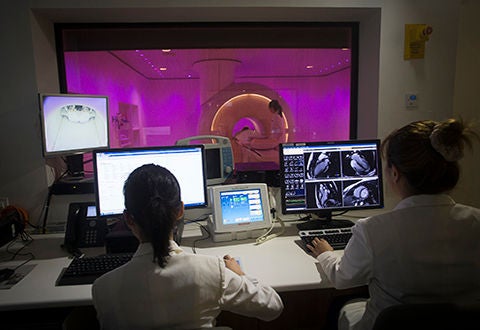
A new heart test, using a stationary bike inside a cardiac MRI scanner, is being used to detect early heart disease.
The Bike CMR combines a Cardiac MRI or CMR scanner with a stationary exercise bike, which the patient pedals for about an hour. This gives cardiologists a better insight into how the heart responds to exercise.
When a young person has an enlarged heart, cardiologists want to know if it is an “athlete’s heart” or heart muscle disease.
An “athlete’s heart” is an enlarged heart that is a normal physiological response to exercise. This is commonly seen in competitive athletes who train more than 10 hours a week.
Recent research suggests that ordinary people who exercise a few hours a week can also have a slightly bigger than normal heart. This is a normal response to an active lifestyle, but a diagnostic dilemma for physicians trying to tell a big heart due to an active lifestyle from one with early heart muscle disease.
In the past, doctors would ask an athlete to stop exercising for a few months to see if his heart returned to a normal size.
Now, a new tool, the Bike CMR, which is a Cardiac MRI (Magnetic Resonance Imaging) scan,` promises better, more accurate results. It combines the CMR with a stationary exercise bike, which gives cardiologists better insight into how the heart responds to exercise.
The National Heart Centre Singapore (NHCS) began using the Bike CMR this year after a study led by Assistant Professor Calvin Chin, Consultant, Department of Cardiology, NHCS, showed it was effective and consistent in investigating enlarged hearts.
Currently, the main indication for using the Bike CMR is to differentiate normal cardiac response to exercise from early heart muscle disease. The test assesses how the heart responds to stress, and compares it against established normal ranges.
It takes about an hour, during which the patient lies supine in the CMR scanner and pedals on a specially designed CMR-compatible bike.
“At every stage of the exercise, we will image the heart to better understand how the heart muscle responds to exercise. It’s a one-stop test for those with suspected heart muscle disease. We can look at heart function and structures, and stress them in one single imaging modality,” said Dr Chin.
Bike versus treadmill
He said exercise is the preferred stress test choice because it is closest to normal functioning. “But we cannot do this effectively by using the exercise treadmill test,” said Dr Chin.
The exercise treadmill cardiovascular MRI has been done at some centres, but it has some limitations. The patient undergoes increasing stages of exercise intensity. At the peak of exercise, he is quickly transferred back to the scanner for cardiac imaging. This may reduce accuracy because the heart rate drops during transfer time.
MRI-compatible exercise treadmill machines have been developed for use in scanner rooms to shorten the transfer time. Comparatively, the Bike CMR provides a more accurate exercise profile of the patient by imaging the heart at every stage of the exercise.
The best candidates for the Bike CMR test are young and very physically active people who may have enlarged hearts.
“When someone relatively young and apparently fit has an enlarged heart, we want to know if it’s due to early heart muscle illness or a physically active lifestyle,” said Dr Chin.
A dilated heart in someone below the age of 35 can be due to a heart muscle illness. For an older person, the cause tends to be coronary artery disease – a blockage in the heart arteries.
Most patients referred to NHCS for the Bike CMR test so far have been men, including national servicemen from the NHCS-run Singapore Armed Forces clinic.
Those who get a normal exercise response but have enlarged hearts would not need treatment. A poor response, however, would point to an underlying heart muscle disease, to be followed up at the cardiomyopathy clinic at NHCS.
Advantages of the CMR
The CMR is considered the gold standard for non-invasive assessment of heart function and volumes. Its powerful magnets and radio frequency pulses create images of the heart’s interior, but the risk is low because it does not involve ionising radiation. Last year, NHCS did more than 2,200 CMR scans, 500 more than the previous year.
A major advantage of using the CMR, unparalleled in other imaging modalities, is its ability to characterise heart muscles with the use of contrast administered through the veins. Abnormal areas of the heart muscle will appear bright in contrast to surrounding normal heart tissue that appears black.
Dr Chin said test use of the Bike CMR can be expanded in the future. It can be used to identify patients, such as those with heart failure, who are at higher risk of developing complications in time to come. This may help doctors prescribe certain treatment options.
For example, patients at high risk of adverse cardiac events will be treated more aggressively with either medication or device therapies.
“The exercise Bike CMR opens a whole world of opportunity in the diagnosis and management of patients with a variety of cardiac diseases. This is an active area of our current research,” said Dr Chin.
Contributed by














 Get it on Google Play
Get it on Google Play